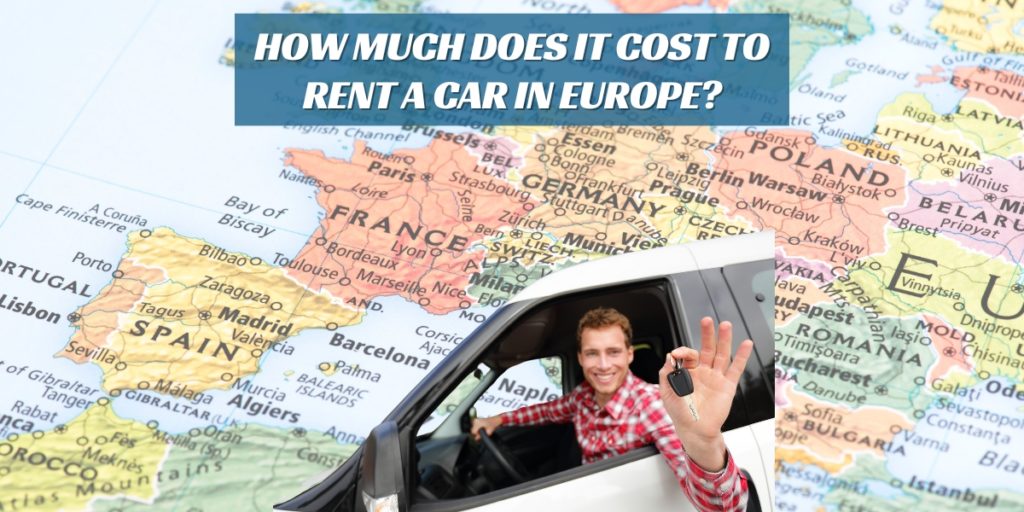Unlocking The Price Tag: How Much It Costs To Rent A Car In Europe

Discover affordable car rental rates in Europe! Find out how much does it cost to rent a car in Europe and plan your adventure with ease.
Unlocking The Price Tag: How Much It Costs To Rent A Car In Europe
There’s no doubt that Europe is the top destination for visitors. The numbers don’t lie, even during the pandemic. Europe has it all: diverse cultures, breathtaking landscapes, delicious cuisine, attractions for all seasons, and all of this in a relatively small area. When exploring what it offers, driving through Europe is an appealing option for many.
For many, renting a car is the most convenient way to explore the continent at their own pace. But how much does it cost to rent a car in Europe? Let’s dive in.
Factors Influencing the Cost of Renting a Car
Everyone has different situations and preferences, which will affect the cost of your rental car in Europe. The price of renting a car in Europe is more than one-size-fits-all.
It can vary based on:
- Type of Car: Your chosen type will significantly influence the price from compact cars to luxury vehicles.
- Country: Some countries are more expensive than others due to higher taxes, maintenance costs, personnel costs, etc.
- Time of Year: Peak tourist seasons can drive up prices. Demand goes up, price goes up.
- Rental Company: Major international companies might have different rates than local ones.
On average, expect to pay between $30-$80 per day or $900-$2400 monthly. However, this can fluctuate based on the above factors. By considering these factors and doing proper research, you can make informed decisions to have a cost-effective car rental experience in Europe.
Country-Specific Averages for Car Rentals
To give you a clearer picture, here are estimated average daily costs in some popular European destinations:
- United Kingdom: $45 ($1,350 per month)
- France: $50 ($1,500 per month)
- Germany: $55 ($1,650 per month)
- Italy: $60 ($1,800 per month)
- Spain: $65 ($1,950 per month)
These averages serve as a guide, but actual costs can vary. The range for mini or compact cars can be $20-$30 per day ($600-$900 monthly).
In my experience, I’ve snagged compact car rentals in Spain—Mallorca and Bilbao—for $20-$25 daily. Prices are variable.
Country-specific averages stress the need to consider your destination when budgeting for a European car rental. Research and compare prices across countries to find the best deal. Opting for cheaper destinations and avoiding pricier areas helps align your car rental with your budget.
Additional Costs of Renting a Car in Europe
When renting a car in Europe, knowing the additional costs that may accompany the rental price is essential. These extra charges can vary depending on the country and the rental company.
Here are some common additional costs to consider beyond the daily rental rate:
- Fuel Charges: Refill the tank before returning to dodge premium refueling charges.
- Insurance Fees: Basic coverage comes with a high deductible. Additional coverage like CDW or TP reduces liability but adds cost.
- Parking Fees: Major cities can be pricey; consider parking fees in your budget.
- Tolls and Vignettes: Expect tolls on highways and the need for vignettes in some countries, especially on longer trips or border crossings.
- Local Taxes: Double-check if taxes are included in the final rental price to avoid surprises.
- Additional Services: Extras like GPS, child seats, or extra drivers may come with added fees. Inquire beforehand to weigh the value against the cost.
Considering these additional costs, you can have a more accurate picture of the overall expense of renting a car in Europe. It’s essential to read the rental agreement carefully and ask the rental company about any potential fees to avoid unexpected charges during your trip.
Tips for Cost-Effective Car Rentals
Here are some tips for cost-effective car rentals in Europe:
- Book Early: Reserve your car for lower rates at least a week ahead.
- Compare: Don’t settle for the first offer; shop for the best deal.
- Local Options: Local companies might offer competitive rates.
- Ask for Discounts: Inquire about AAA, corporate, or other discounts.
- Go for Major Brands: Brands like Hertz, Avis, Budget, Europcar, or Sixt can offer better support and more extensive car inventories.
- Prepay: Paying in advance usually saves money and avoids international transaction fees.
- Check Cancellation Fees: Review cancellation fees if plans change; prepaying might still be cheaper.
- Know Border Crossing Costs: Expect tolls, vignettes, or insurance requirements for border crossings; research each country’s regulations.
Following these tips can increase your chances of finding a cost-effective car rental in Europe. Remember to compare prices, read the rental terms and conditions, and choose the options that best fit your budget and travel needs.
Car Rental: Convenient Pick-Up Spots
Renting and returning a car at the same spot usually saves money. Dropping off in another city or country incurs fees, which are incredibly hefty.
Major hubs like airports often offer better deals. When our flight rerouted from Charleroi to Cologne, a day rental between airports hit €486, way above the usual €65/day. Opting for a €100 cheaper private transfer lets us relax in comfort.
In Spain, dropping off a car just an hour away spiked prices from €36 to €108. Crossing borders means soaring costs, so reconsider plans involving inter-country drop-offs.
Seasonal Variations Affect Car Rental Costs
When planning a European car rental, seasonal variations are a factor in affecting costs.
- December is the budget champion for small cars at $18 daily, while July peaks at $49. Opting for December equals savings if you’re okay with winter trips.
- October steals the spotlight for medium car rentals at $35 daily, while July hits $110. October’s lower rates are a wallet-friendly pick for a mid-sized European adventure.
- Large cars hit a low in February at $93 daily, soaring to $204 in June. If space matters, February brings substantial savings.
- SUV lovers, November’s $43 daily beats July’s $87. November’s affordability is a boon for European adventurers.
- March dominates van rentals at $51 daily, compared to July’s $185. Traveling in a group or with luggage? March is easier on the wallet.
Finding reasonably priced rentals is usually easy if you’re flexible on the car type. In June 2023, the packed parking garage at Cologne airport had me wondering about daily vehicle occupancy. Multiple upgrades were offered at check-in, adding surprise to the experience.
Long-Term Car Rentals
Long-term car rentals in Europe are a budget-friendly choice for exploring at your own pace. A month-long rental averages around $1,034 ($34 per day), but prices vary by destination and rental company.
Booking seven days ahead can save up to 33% on rentals. DMR Car offers the best deal, cutting prices by 73% compared to the average.
Availability depends on the rental company’s inventory, so check for the right vehicle in advance.
Consider extra expenses like fuel, tolls, and parking fees. Also, get travel insurance covering rental car damage or loss for peace of mind during your long-term rental.
In essence, long-term rentals in Europe save money compared to short-term ones. Plan, compare prices, and consider additional costs and insurance for a smooth European journey.
Private Car Rentals
Consider renting cars from local individuals instead. It’s another option to explore.
Yet, they present their unique challenges:
- Restrictions: Not everyone might be eligible to rent. For example, only residents can rent.
- Older Cars: Typically, these cars are older models. They are not a deal breaker, but they often are only a little cheaper than car rental companies.
- Insurance: Limited insurance options can be a concern. Some websites charge extra for insurance or require you to have your own.
- Drop-Off: You’ll likely have to return the car where you got it. It is okay if you’re staying within the given area.
- Limited Mileage: Many private car rental websites and owners often impose strict mileage limits to prevent vehicle misuse or excessive use.
- Language Barriers: Interacting with local owners could mean speaking their language. It’s essential for communication. While most can get by with English, some owners may need help to speak it to a level that provides a hassle-free rental experience.
A Game-Changing Alternative for Long-Term Car Rentals
Leasing a car for an extended European adventure beats regular leasing. It’s wise for extensive exploration or a reliable ride over time, promising significant savings and cost predictability.
Extended leases, typically 17 days to 1 year, offer hefty cost advantages. Companies often switch to fixed monthly rates, simplifying budgeting compared to daily or weekly payments.
Unlimited mileage is the gem! Roam freely across countries without fretting about extra fees, ideal for embracing Europe’s diverse landscapes and cultures.
Some leases cover everything: maintenance, roadside assistance, and insurance. No last-minute surprises or juggling separate insurance plans. It keeps long-term travel stress-free, letting you focus on the journey.
CarTurf: Your Shortcut to Seamless Car Ownership in Europe
Another option? Check out CarTurf. Feeling overwhelmed? They streamline buying—paperwork, insurance, registration—all sorted. Arrive in Europe, and your wheels await. It is a savvy move, especially for more extended stays, beating traditional leasing.
Read about how CarTurf can cut your rental car costs in half by helping you buy a car to drive in Europe instead of renting one. They handle everything, ensuring you land in Europe with a ready-to-go car.
Conclusion on Car Rentals in Europe
Exploring Europe by renting a car grants the freedom to discover hidden treasures and less-traveled locations. While costs can vary, with some research and planning, you can find a deal that fits your budget. And if you’re up for an adventure, consider buying a car for your long-term European escapade with CarTurf by your side the whole time. Safe travels!






